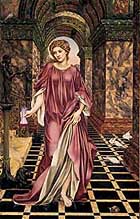
The Myth of Florence in the Pre-Raphaelite milieu and in American culture between the nineteenth and twentieth centuries.
April 6 - August 31, 2004
Galleria degli Uffizi, Florence
Hours: Open from Tuesday until Sunday, 8:15 am - 6:50 pm. Ticket office closes at 6:05 pm. Closed Mondays.
TICKET PRICES: Full rate: € 9.50 Concession: € 4.25.
During the course of the nineteenth century, an idea of Florence gradually developed in the international imagination. The phenomenon was particularly rooted in Anglo-American culture and ended up becoming a literary myth and tourist stereotype. This Exhibition traces an ideal map of the less conventional aspects of the figurative and architectural culture of post-unity Tuscany . It leads us to discover that Florence could very well represent a transfigured destination - neo-medieval and neo-renaissance - for those visitors (including the queens of the Ruskin-inspired exhibition title) who, in the city and its outlying territory, found inspiration for the aesthetic and literary accomplishments they left us.
Florence was the place par excellence of the revisitation of renaissance memories, centre of a cosmopolitan culture promoted and exalted by a goodly number of foreigners, città felix , garden of Europe , showcase of taste and style where nature, art and life wondrously came together. Florence was the place where, as American writer Edith Wharton wrote, "You may go forth from the Riccardi Chapel and see the castle of Vincigliata towering on its cypress-clad hill precisely as Gozzoli depicted it in his fresco". How did Florence and its "myth" inspire both men and women artists who lived here? The wondrous views of the city from the hill of Bellosguardo in the static perfection of Giuseppe Maria Terreni's eighteenth-century painting, and of another work painted fifty years later by Thomas Hartley Cromeck, visually reproduce the emotions of visitors who looked out from the terrace of Villa Brichieri, along with those of the characters of their narrations.
|
|
|
 |
|
|


